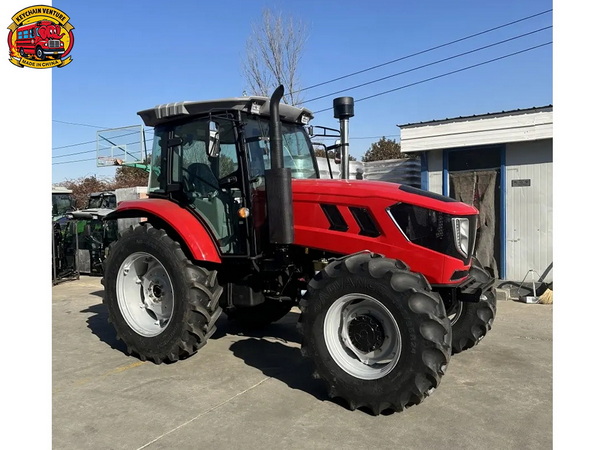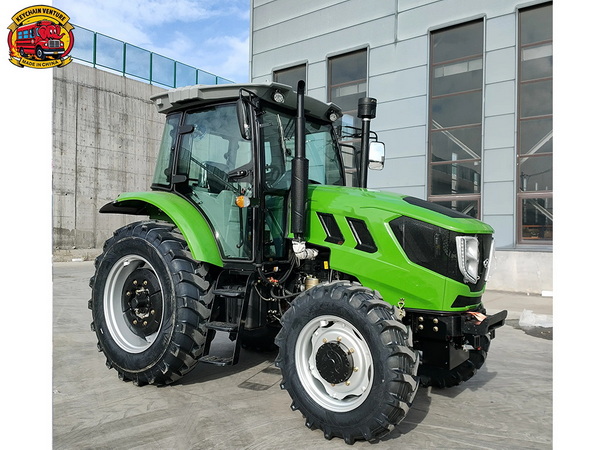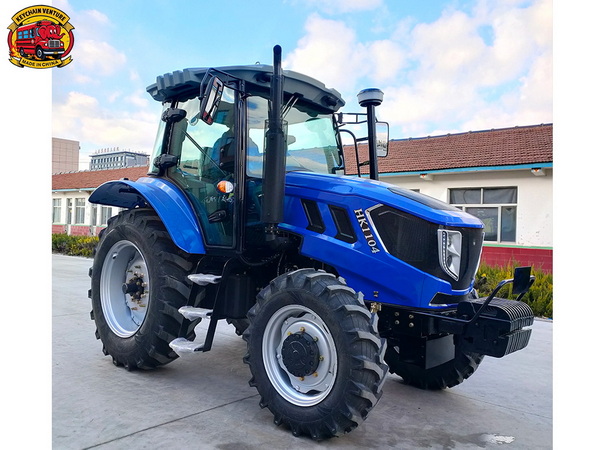Views: 222 Author: Amanda Publish Time: 2025-10-12 Origin: Site








Content Menu
● Understanding the Tractor: The Backbone of Heavy Hauling
● Design Characteristics of a Conventional Tractor
● Conventional Tractor Versus Cab-Over Tractor
● Practical Uses and Applications of Conventional Tractors
>> Axle Load and Weight Distribution
● Advantages of Conventional Tractors
● Challenges and Considerations
● The Future of Conventional Tractors
● Frequently Asked Questions (FAQ)
>> 1. What is the main difference between a conventional tractor and a cab-over tractor?
>> 2. Why are conventional tractors more popular in North America?
>> 3. What types of loads can a conventional tractor haul?
>> 4. How does the fifth wheel coupling work on a conventional tractor?
>> 5. Are there hybrid or electric conventional tractors available?
In the world of commercial transportation, the term "tractor" often evokes the image of powerful vehicles designed to haul heavy loads across vast distances. Among various types, the conventional tractor stands out as a defining figure of the trucking industry. But what exactly is a conventional tractor, and how does it differ from other types of tractor-trailers? This comprehensive article explores every facet of the conventional tractor—its design, uses, advantages, and role in modern logistics.

A tractor is a specialized heavy-duty vehicle designed primarily to tow trailers loaded with goods. It serves as the engine and control center of a tractor-trailer combination, capable of hauling everything from commodities to construction materials over highways and rough terrains. The conventional tractor, in particular, features a characteristic layout where the engine is housed in a long hooded section in front of the driver's cab, distinguishing it from other configurations like cab-over-engine designs.
One of the most defining visual traits of the conventional tractor is its "dog nose" or long bonnet design. The engine resides under this extended hood at the front of the vehicle, with the driver's cab positioned behind it. This arrangement is reminiscent of a typical passenger car's structure, providing certain mechanical and ergonomic advantages.
Conventional tractors are built on robust truck chassis classified as heavy-duty (Class 8 in North America). Typical axle configurations include 4×2, 6×2, and 6×4, with more specialized models featuring multiple driven and steering axles for enhanced load distribution and traction.
- 4×2: Two axles with one driven; suited for lighter hauling.
- 6×4: Three axles, typically two rear driven, common for long-distance haulage.
- 6×2: Three axles with one rear axle driven and one liftable axle for tire wear reduction.
More heavy-duty or specialized tractors may have 8×4, 8×6, or even 10×10 configurations to meet demanding operational requirements.
One of the most frequently discussed comparisons in trucking is between conventional tractors and cab-over-engine (COE) tractors.
Conventional tractors have the engine housed under a long hood that extends ahead of the cab, providing a substantial frontal buffer for impact protection. In contrast, cab-over tractors position the driver's cab directly above or slightly ahead of the front axle, resulting in a shorter overall vehicle length.
This difference strongly influences various operational factors including driver visibility, vehicle maneuverability, maintenance, and safety:
- Overall length: Conventional tractors are longer, which can decrease maneuverability in urban or confined spaces but permit larger cabs and better ride comfort.
- Driver visibility: COE models usually offer better forward visibility due to the cab-forward design.
- Maintenance ease: The conventional design allows easier engine access through the front hood.
- Crash safety: The extended hood provides a crumple zone shielding drivers better in frontal collisions.
- Regulatory impact: In regions with strict overall length limits on trucks, COE designs are more prevalent to maximize trailer length within total allowed lengths.
Overall, conventional tractors dominate markets like North America and Australia where length regulations favor their benefits, while COE models remain popular in Europe and Asia.
Conventional tractors are highly versatile and dominate many freight hauling markets, especially in the United States. Their powerful diesel engines, ranging typically from 250 to 700 horsepower, and durable transmissions make them capable of handling a wide range of trailer types including:
- Flatbeds for carrying construction materials, machinery, and oversized loads.
- Tank trailers transporting liquids such as fuels, chemicals, or food-grade products.
- Refrigerated trailers for perishable goods requiring temperature control.
- Dry vans used for general freight and logistics.
- Heavy equipment trailers for hauling construction or agricultural machines.
They excel in long-haul trucking, regional deliveries, and heavy-duty applications where driver comfort, power, and safety are prioritized. Their design allows for spacious sleeper cabs equipped for drivers spending extended periods on the road. The conventional tractor's robust engineering ensures reliable performance even under rigorous and varied operating conditions.

Conventional tractors use large displacement diesel engines tailored for high torque and fuel efficiency necessary for hauling heavy loads. Typical engines range in horsepower from about 250 HP on lighter models to over 700 HP in specialized heavy-haul tractors.
They come paired with manual, automated manual, or fully automatic transmissions featuring multiple gear ratios—typically 8 to 18 speeds—to optimize engine performance across various terrains. Advanced transmission selections allow drivers to maintain control, improve fuel economy, and reduce wear.
A key component of any tractor is the fifth wheel coupling, a large horseshoe-shaped plate mounted directly behind the cab. This mechanism connects the tractor to a semi-trailer and allows the trailer to pivot horizontally while securely attached, enabling sharp turns and flexibility on roads and highways.
The fifth wheel is engineered for strength and durability, designed to withstand the tremendous forces that the tractor-trailer combination exerts, especially while braking or turning with heavy cargo.
Axle configuration on conventional tractors is carefully designed to balance the vehicle's weight distribution and adhere to road regulations. Adjustable axles allow for optimized tire wear and cost savings on tolls where pricing is based on axle counts. Steerable lift axles improve maneuverability and reduce wear when the tractor runs empty or lightly loaded.
With precise weight management, conventional tractors maximize cargo efficiency while ensuring vehicle safety and compliance with freight regulations.
Conventional tractors offer several advantages that make them favored vehicles in many trucking segments:
- Enhanced safety: The hooded engine ahead of the cab acts as a buffer zone that absorbs impact forces, reducing injury risk in frontal collisions.
- Driver comfort: The design allows for larger, quieter, and better-insulated cabs, often fitted with sleeper compartments ideal for long-haul drivers.
- Ease of maintenance: Engine components are accessible via the front hood, simplifying routine servicing and reducing downtime.
- Powertrain flexibility: Large engine bays accommodate a wider range of high-powered engines and transmissions tailored for diverse applications.
- Fuel efficiency: Modern aerodynamic modifications and engine technologies improve miles per gallon, which is crucial for reducing operational costs on extended trips.
Despite their many strengths, conventional tractors do have some limitations:
- Longer total vehicle length: This impacts maneuverability and parking in urban or space-restricted environments.
- Higher initial costs: Larger engine and cab designs can be more expensive to manufacture and purchase.
- Regulatory constraints: In areas where strict overall vehicle length limits apply, conventional tractors might reduce the allowable trailer size, limiting load capacity.
- Fuel consumption variability: While aerodynamic improvements help, larger frontal areas generally mean higher fuel use compared to some more compact designs.
Fleet managers often weigh these factors against hauling needs and operational geography when choosing tractor types.
The trucking industry is undergoing rapid transformation driven by sustainability goals and technological advances. Conventional tractors are evolving with this trend:
- Hybrid and electric powertrains: Manufacturers are developing hybrid diesel-electric and fully electric conventional tractors to cut emissions and comply with tightening environmental standards.
- Advanced aerodynamics: New designs feature optimized shapes and add-ons—such as side skirts, roof fairings, and wheel covers—to reduce drag and improve fuel economy.
- Smart technologies: Integration of telematics, driver assistance systems, and autonomous driving features enhance safety, efficiency, and operational management.
- Lightweight materials: Use of composites and high-strength alloys reduces vehicle weight without sacrificing durability.
As these innovations mature, the conventional tractor remains poised to maintain its vital role in freight transportation well into the future.
The conventional tractor remains a cornerstone of heavy-duty trucking, especially in markets that prioritize power, safety, and driver comfort. Its distinctive long-hood design offers mechanical benefits and enhanced crash protection, making it a preferred choice for long-haul and heavy-load applications. While cab-over-engine tractors dominate other regions due to space and length limitations, the conventional tractor endures in prominence due to its robustness and versatility. As the industry moves towards greener technologies, conventional tractors continue to evolve, holding a vital place in the logistics and transport landscape.

The main difference lies in engine placement; conventional tractors have a long hood with the engine in front of the cab, while cab-over tractors have the cab sitting above or ahead of the engine, resulting in a shorter overall length.
North America has more relaxed length regulations allowing longer tractor-trailer combinations, favoring the conventional tractor design which offers better driver comfort and safety.
Conventional tractors can haul a vast range of loads including flatbeds, refrigerated trailers, tankers, dry cargo vans, and heavy equipment trailers.
The fifth wheel is a pivot plate behind the cab that attaches to the trailer's kingpin, allowing the trailer to turn and pivot while securely connected to the tractor.
Yes, manufacturers are increasingly producing hybrid and fully electric conventional tractors to reduce emissions and improve fuel efficiency for sustainable trucking.